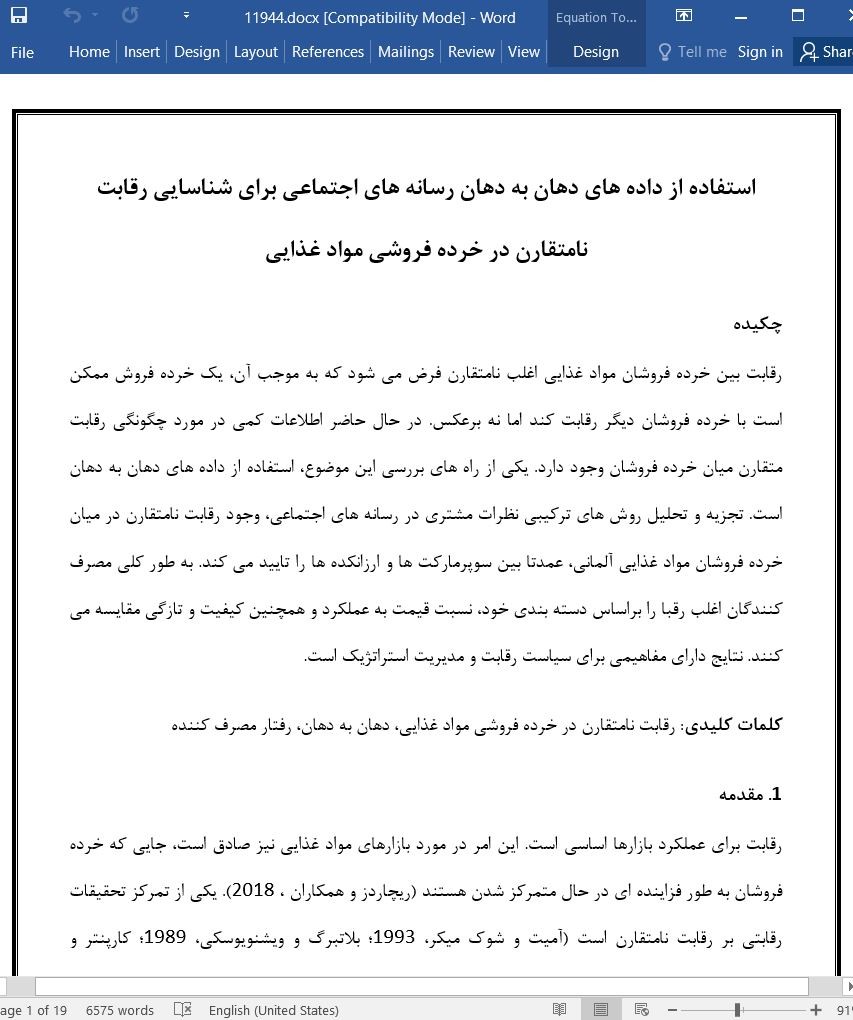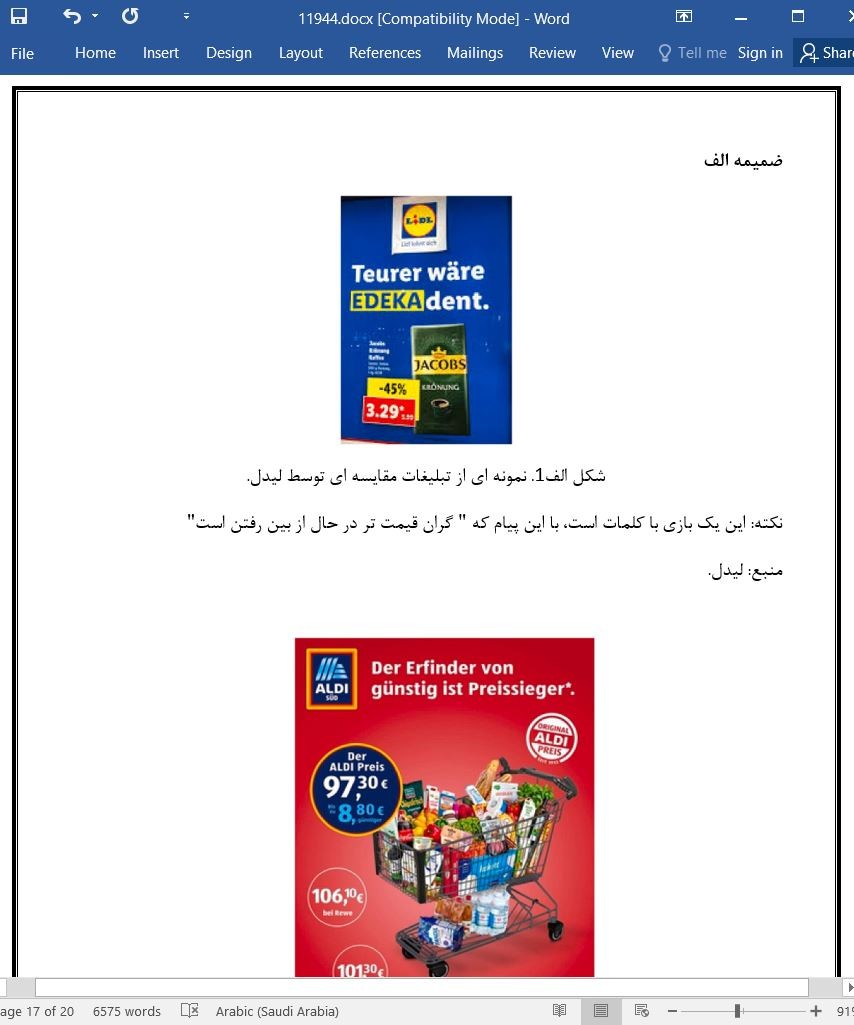
استفاده از داده های دهان به دهان رسانه های اجتماعی برای شناسایی رقابت نامتقارن در خرده فروشی مواد غذایی
چکیده
رقابت بین خرده فروشان مواد غذایی اغلب نامتقارن فرض می شود که به موجب آن، یک خرده فروش ممکن است با خرده فروشان دیگر رقابت کند اما نه برعکس. در حال حاضر اطلاعات کمی در مورد چگونگی رقابت متقارن میان خرده فروشان وجود دارد. یکی از راه های بررسی این موضوع، استفاده از داده های دهان به دهان است. تجزیه و تحلیل روش های ترکیبی نظرات مشتری در رسانه های اجتماعی، وجود رقابت نامتقارن در میان خرده فروشان مواد غذایی آلمانی، عمدتا بین سوپرمارکت ها و ارزانکده ها را تایید می کند. به طور کلی مصرف کنندگان اغلب رقبا را براساس دسته بندی خود، نسبت قیمت به عملکرد و همچنین کیفیت و تازگی مقایسه می کنند. نتایج دارای مفاهیمی برای سیاست رقابت و مدیریت استراتژیک است.
1. مقدمه
رقابت برای عملکرد بازارها اساسی است. این امر در مورد بازارهای مواد غذایی نیز صادق است، جایی که خرده فروشان به طور فزاینده ای در حال متمرکز شدن هستند (ریچاردز و همکاران ، 2018). یکی از تمرکز تحقیقات رقابتی بر رقابت نامتقارن است (آمیت و شوک میکر، 1993؛ بلاتبرگ و ویشنویوسکی، 1989؛ کارپنتر و همکاران، 1988؛ چن، 1996؛ دساربو و همکاران، 2006). عبارت "رقابت نامتقارن"، میزان عدم توازن شرکت ها در رقابت با یکدیگر را توصیف می کند. به عنوان مثال، مشتریان یک سوپرمارکت ممکن است فروشگاه مجاور را به عنوان یک جایگزین خرید ببینند؛ در حالی که مشتریان ارزانکده ها ممکن است سوپرمارکت را به عنوان جایگزینی برای خرید مواد غذایی خود در نظر نگیرند. در حالی که مجموعه تحقیقاتی موجود نشان می دهد که به ویژه بین ساختارهای فروشگاه، رقابت نامتقارن وجود دارد (کلیرن و همکاران ۲۰۱۰؛ گونزالس - بنیتو و همکاران ۲۰۰۵)، استراتژی هایی مانند فهرست کردن محصولات برند شده توسط ارزانکده ها، نشانه ای از این هستند که در دوران اخیر، رقابت بین و درون ساختارها تغییر کرده است (کاردینالی و بلینی ۲۰۱۴؛ وبلاگ خرده فروشی آلمان، ۲۰۱۲). اندا زه گیری و درک این تعاملات رقابتی برای شرکت های خرده فروشی که می خواهند مزیت رقابتی ایجاد کنند و مدیران عمومی که رقابت را تنظیم می کنند، اساسی است (دابسون و همکاران، ۲۰۰۳؛ گونزالس - بنیتو و همکاران، ۲۰۰۵؛ حسین و همکاران، ۲۰۲۰).
Abstract
Competition between food retailers is often assumed to be asymmetrical, whereby one retailer may compete with another retailer but not vice versa. Little is known about how (a)symmetric competition among retailers currently is. One way to investigate this is to use word of mouth data. A mixed methods analysis of customer comments on social media confirms the existence of asymmetric competition among German food retailers, mainly between supermarkets and discounters. Overall, consumers compare competitors frequently on the basis of their assortments, the price-performance ratio as well as quality and freshness. The results have implications for competition policy and strategic management.
1. Introduction
Competition is fundamental to the functioning of markets. This also applies to food markets, where retailers are becoming increasingly concentrated (Richards et al., 2018). One focus of competitive investigations is on so-called asymmetric competition (Amit and Schoemaker, 1993; Blattberg and Wisniewski, 1989; Carpenter et al., 1988; Chen, 1996; DeSarbo et al., 2006). The term “asymmetric competition” describes the extent to which companies are unevenly in competition with each other. For example, the customers of a supermarket may see a nearby discounter as a shopping alternative; while the customers of the discounter may not consider the supermarket as an alternative for their food purchases. While the existing body of research suggests that asymmetric competition exists especially between store formats (Cleeren et al., 2010; Gonz´ alez-Benito et al., 2005), strategies such as the listing of branded products by discounters are a sign that the competition between and within formats has changed in recent times (Cardinali and Bellini, 2014; German Retail Blog, 2012). Measuring and understanding these competitive interactions is fundamental for retail firms who want to create competitive advantage and public administrators who regulate competition (Dobson et al., 2003; Gonzalez-Benito et al., ´ 2005; Hossain et al., 2020).
چکیده
1. مقدمه
2. پیشینه
2.1 شواهد تجربی
2.2 پیشینه نظری
3. داده ها و روش
4. نتایج
5. بحث و نتیجه گیری
5.1 مفاهیم نظری
5.2 مفهوم عملی
5.3 محدودیت ها
ضمیمه الف
ضمیمه ب. داده های تکمیلی
منابع
Abstract
1. Introduction
2. Background
2.1. Empirical evidence
2.2. Theoretical background
3. Data and method
4. Results
5. Discussion and conclusion
5.1. Theoretical implications
5.2. Practical implications
5.3. Limitations
Appendix A.
Appendix B. Supplementary data
Research Data
References
- اصل مقاله انگلیسی با فرمت ورد (word) با قابلیت ویرایش
- ترجمه فارسی مقاله با فرمت ورد (word) با قابلیت ویرایش، بدون آرم سایت ای ترجمه
- ترجمه فارسی مقاله با فرمت pdf، بدون آرم سایت ای ترجمه



